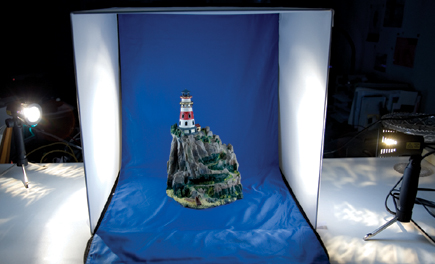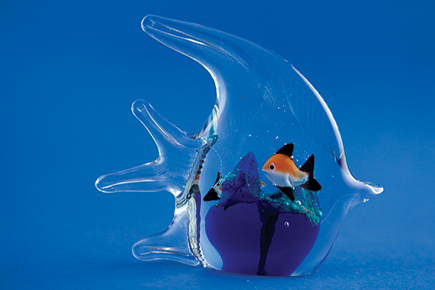A Tabletop Lighting System Sampler; We Work With The Lowel Ego, Interfit Pop-Up Light Tent, Sharpics D-Flector, Samigon Internet Photo Studio Pro, And Sunpak eBox Page 2
 |
|
|
|
 |
|
|
|
|
Here's what I found:
Lowel Ego Digital Imaging Light System plus Ego-sweep (under $200/kit). The
complete Ego tabletop solution consists of what are essentially two light banks,
each with two spiral fluorescent bulbs, plus two corrugated-plastic self-standing
reflector panels, a self-standing backdrop support with clips, and a set of
seamless papers in a variety of colors. It's fairly easy to put together
and set up, and very easy to use. I was surprised by how much I enjoyed working
with this system. The reflector panels are especially handy, since they are
translucent enough to serve as scrims to block out excessive light.
In fact, they proved so handy I used them with other tabletop sets as well.
(Lowel-Light Mfg.) Sharpics D-Flector Portable Photo Studio DF-20 with Compact
Studio Light Kit LKT-92 (under $250 complete). When I saw the D-Flector at PMA
and popped an on-camera flash at a toy car, I was impressed by the lack of shadows,
expecting the same when it was part of an integrated system. The reflective
silver backdrop didn't do as well when sidelighting was employed with
the lights that came in the kit, although it did better than most backdrops
to soak up the shadows. Each light sports a fairly wide-dispersal reflector
(dish), so you might consider using blackwrap (commercially known as Cinefoil,
available at pro photo shops) to better control the light spread with some subjects
(use this metal foil around the dish to form a snoot of sorts). (Sharpics.)
Sunpak eBox Portable Photo Studio ($65). This is the most portable tabletop
lighting system in the bunch, and very smartly designed. To all outward appearances,
it's a black nylon portfolio case. The case opens to reveal flaps that
fold out to form a cube with a reversible fabric backdrop. The portfolio-style
case carries two tungsten lights in outside pockets. There's also a tabletop
tripod for point-and-shooters (in another outside pocket), not for use with
an SLR. This tent is the perfect size for small items, although it had little
trouble dealing with something as large as the aquarium ornament. While tungsten
lighting is not my favorite, these tiny lights make this a tidy solution, especially
for someone crafting jewelry at home for online sales. I wouldn't use
it to photograph an ice cream sundae or other perishables. (ToCAD America.)
Interfit 24" Pop-Up Light Tent with Three-Bulb Cool-lite Kit ($299/kit).
Pop-up tents open quickly and fold down to practically nothing. But the lights
are another story--they are massive compared with other lights in this
group, making them more of a full-time studio solution, especially when you
add the stands (included). That said, these lights are equally suited for use
in studio portraiture. They also come with a diffusion cap as an immediate and
practical means of reducing output and softening the light. The kits can actually
be configured differently--you might want a five-bulb system for more power
if you like to work with smaller f/stops. Available in several sizes, the pop-up
tent comes with a removable blue backdrop and a pull-away front flap with a
slit--poke the lens through the slit, or, to avoid the white nylon reflecting
in shiny objects, remove the flap. I found it easier to work with the tent wide-open
in front, although I did have to drape some black fabric around the lens to
cut back on reflections. (Interfit Photographic.)
Samigon Internet Photo Studio Pro (under $500). This system evolved from the
more modest Internet Photo Studio and is a big step up. I'd tested the
earlier model sometime back and when Argraph developed a more robust sibling,
I eagerly sought it out. It's a rather clever system, beginning with a
light box (the kind used for viewing slides) as the base. But here is where
it gets interesting. The kit comes with two light heads that attach to extending
arms (reaching as high as 2 ft), and these arms attach along the sides, front,
or back of the metal-walled light box with industrial-strength magnets at their
base (the magnetic field appears fairly well shielded, but I would avoid holding
these magnets too close to electronic components or magnetic media). An integral
component is a background support over which you drape any background material,
from seamless paper to fabric (such as black velvet) or vinyl, extending this
material over the front lip of the light box. Black brackets front and back
secure the sliding Plexiglas sheet. Because the black might show through some
background materials, I removed it from the rear of the box, where the background
support stood--three screws hold it in place. You need to be careful when
adjusting the lights, as they loosen easily--be sure to tighten them regularly,
especially the base. Aside from that, setup and operation were simple. (Argraph.)
 |
|
|
|
 |
|
|
|
 |
|
|
|
 |
|
|
|
 |
|
|
|
 |
|
|
- Log in or register to post comments

































